|
|
Just Timeless:
A Fish-Plate proving that Ancient Art never gets old
|
They lively romp around the plate, four sea breams and a sardine, with their bellies pressed against the rim, their round eyes wide, almost anxiously open. They are in movement, in excited movement, the fins placed on the chest, the ones at the back streched out, the whole scenery framed by a black wavy band. In masterful manner the Greek painter captured this scene around 380 B.C. in Athens on a small terracotta plate. So masterly that art connoisseurs are amazed how vivid, realistic and yet inimitable the rare fish-plate by the Alcácer do Sal painter (named after the reference plate found in Portugal) is still today.
|
Save the Date: Thursday, 11 April, 6 p.m. Of course there are countless other examples of the influence of ancient art on modern times. Who doesn't recognize in the "Lady of Fashion" on the Apulian amphora the muse for Picasso? Or in the Egyptian djed pillar, which stands for the backbone of Osiris, one for 20th century abstraction? Please look forward to our major spring exhibition in which we will showcase this theme. Featuring: Venus and Matisse, Modigliani and Cycladic art. Opening on Thursday, 11 April, 6 p.m.
|
|
Zeitlose Kunst: Ein Fischteller, der zeigt, warum die Antike niemals alt wird
|
Quirlig tummeln sie sich auf dem Teller, die vier Brassen und die Sardine, ihre Bäuche an den Rand gedrückt, die runden Augen weit, fast ängstlich geöffnet. Sie sind in Bewegung, in aufgeregter Bewegung, die Flossen an der Brust angelegt, hinten weggestreckt, die ganze Szene von einem schwarzen Wellenband am Rand umgeben. In geradezu meisterhafter Manier hat der griechische Maler um 380 v. Chr. diese Szene in Athen auf einen kleinen Tonteller gemalt. So meisterhaft, dass Kunstkenner staunen, wie lebendig, naturgetreu und trotzdem unnachahmlich der seltene Fischteller des Alcácer do Sal-Malers (bennant nach einem Referenzteller, der in Portugal gefunden wurde) noch heute ist.
|
Save the Date: Donnerstag, 11. April, 18.00 Uhr. Der Einfluss der antiken Kunst auf die Moderne kennt natürlich noch unzählige weitere Beispiele. Wer erkennt in der "Lady of Fashion" auf der apulischen Amphore nicht ein Vorbild für Picasso? Oder im ägyptischen Djed-Pfeiler, der für das Rückgrat des Osiris steht, eines für die Abstraktion des 20. Jahrhunderts? Freuen Sie sich mit uns auf unsere große Frühjahrsausstellung, in der wir uns mit diesem Thema auseinandersetzen. Mit dabei: Venus und Matisse, Modigilani und die Kunst der Kykladen. Eröffnung am Donnerstag 11. April um 18.00 Uhr.
|
|
|
|
Our Highlight of the Month:
|
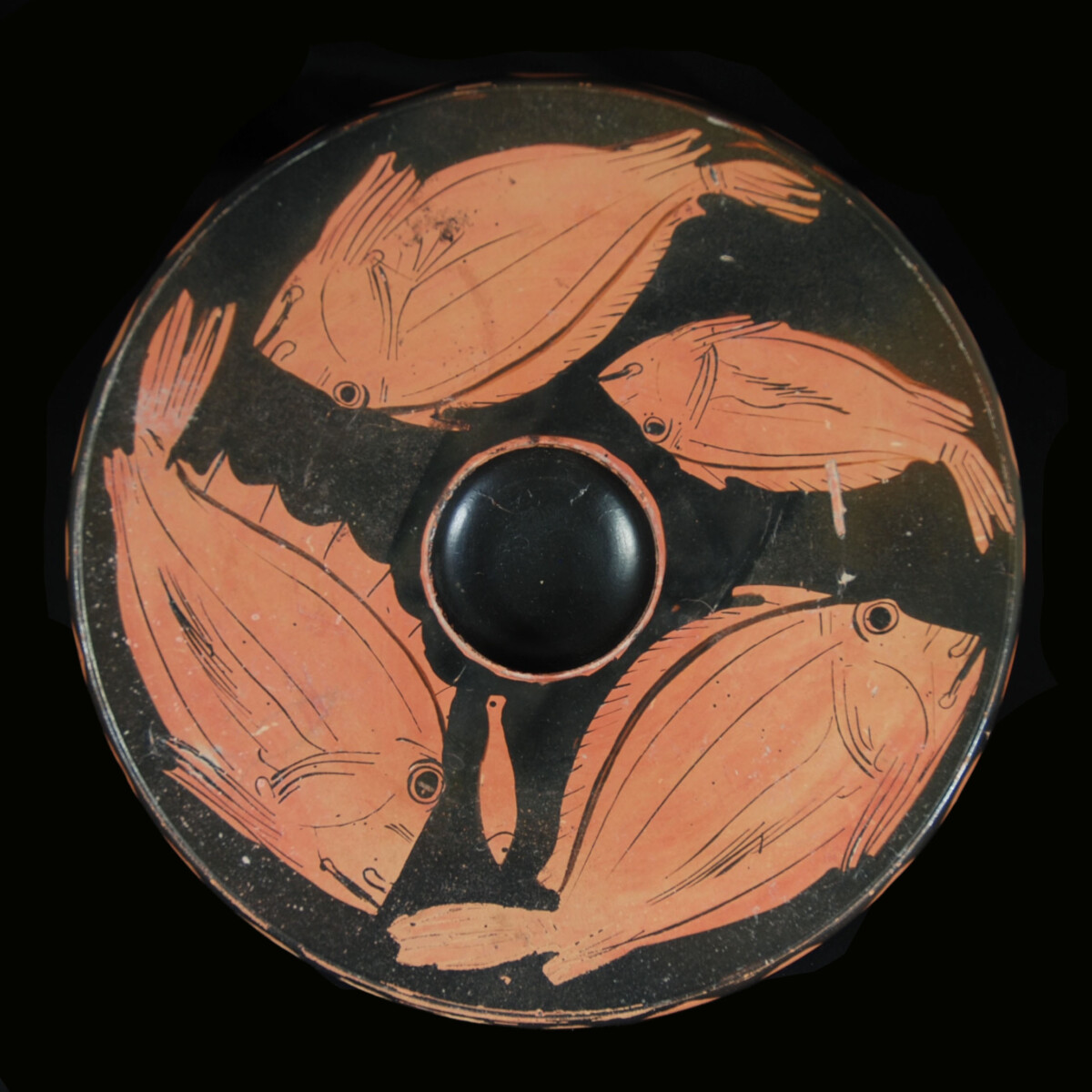
|
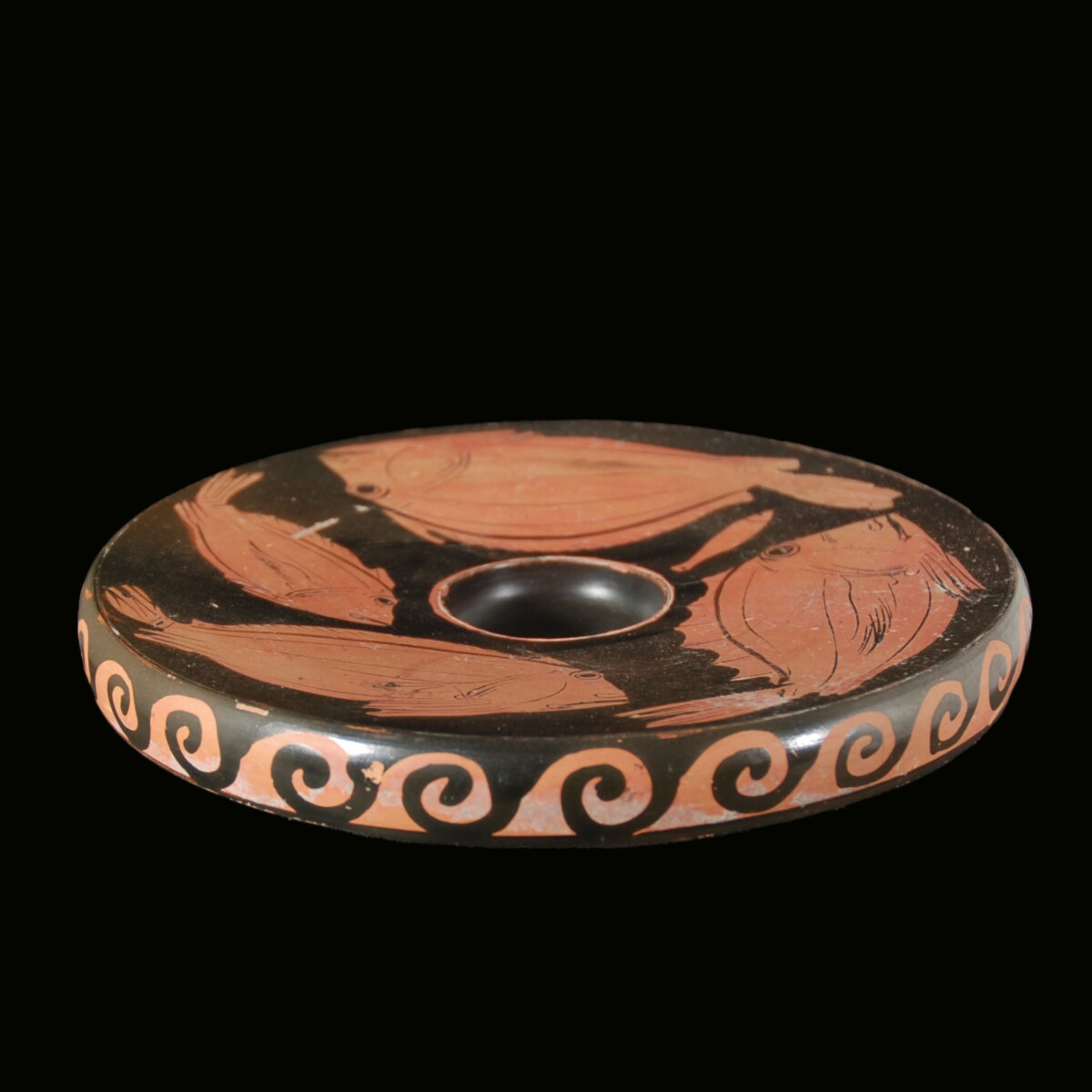
|
|
|
Exceedingly rare, completely preserved red-figure fishplate from the Attic workshop of the Alcácer do Sal painter. The black-primed image area, which slightly cascades towards the centre, depicts four sea breams (sparidae), three large and a small one, swimming counterclockwise with the bellies outwards. Between two of the large sea breams is the depiction of a small fish, possibly a sardine. The indentation in the centre is precisely rounded and black glazed. The rim is pulled outwards and decorated with a black wavy band. The fishplate stands on a slightly set off foot ring, the bottom is pulled outwards and has the black, concentric circles with a centre that are typical for Attic ceramic. The rare Attic fishplate was made in Athens’ Kerameikos and is published in: Charles Ede Gallery “Pottery from Athens”, Vol. XIV, number 21. See for a very similar fishplate in: I. McPhee and A.D. Trendall “Addenda to Greek Red-figured Fish-Plates”. Antike Kunst 33, Basel 1990, p. 36, no. 66b with fig. 8,4. See for the Alcácer do Sal painter: I. McPhee und A.D. Trendall “Greek Red-figured Fish-Plates”. Antike Kunst Beiheft 14, Basel 1987, p. 38 f. The painter was named after the site of the Lisbon plate 11.241 in southern Portugal. The reference plate is also published in I. McPhee und A.D. Trendall “Greek Red-figured Fish-Plates” (p. 39, no. 69).
|
Provenance: Swiss private collection Sorengo, acquired around 1990. Thence with Charles Ede in London 1995. There published in "Pottery from Athens", Vol. XIV. number 21. Last in a US private collection.
Dimensions: 18.7 cm in diameter
Price: 28 000 Euro
|
|
|
Griechenland – um 380 v. Chr.
|
Überaus seltener, komplett erhaltener rotfiguriger Fischteller aus der attischen Werkstatt des Alcácer do Sal-Malers. Die leicht zur Mitte hin abfallende, schwarz grundierte Bildfläche zeigt vier Meeresbrassen (Sparidae), drei große und eine kleine, die gegen den Uhrzeigersinn, mit dem Bauch nach außen schwimmen. Zwischen zwei der großen Brassen ist ein Kleinfisch, wohl eine Sardine, dargestellt. Die Vertiefung in der Mitte ist präzise abgerundet und ebenfalls schwarz glasiert. Der Rand ist nach außen gewölbt und mit einem schwarzen Wellenband verziert. Der Fischteller steht auf einem leicht abgesetzten Standring, die Unterseite ist nach außen gewölbt und weist die für die attische Keramik typischen schwarzen, konzentrischen Kreise mit Mittelpunkt auf. Der seltene attische Fischteller wurde im Athener Kerameikos hergestellt und ist publiziert in: Charles Ede Gallery „Pottery from Athens“, Vol. XIV, Nummer 21. Vergleiche einen sehr ähnlichen Fischteller in: I. McPhee und A.D. Trendall „Addenda to Greek Red-figured Fish-Plates“. Antike Kunst 33, Basel 1990, S. 36, Nr. 66b mit Taf. 8,4. Vergleiche allgemein zum Alcácer do Sal-Maler: I. McPhee und A.D. Trendall „Greek Red-figured Fish-Plates“. Antike Kunst Beiheft 14, Basel 1987, S. 38 f. Seinen Namen erhielt der Maler nach dem Fundort des Tellers Lissabon 11.241 im südlichen Portugal. Der Referenzteller ist ebenfalls bei I. McPhee und A.D. Trendall „Greek Red-figured Fish-Plates“ (S. 39, Nr. 69) publiziert.
|
Provenienz: Schweizer Privatsammlung Sorengo, erworben um 1990. Danach bei Charles Ede in London 1995. Dort publiziert in: „Pottery from Athens“, Vol. XIV, Nummer 21. Zuletzt in amerikanischem Privatbesitz.
Durchmesser: 18,7 cm
Preis: 28.000 Euro
|
|
|
|
Selected Artworks of the Month:
|
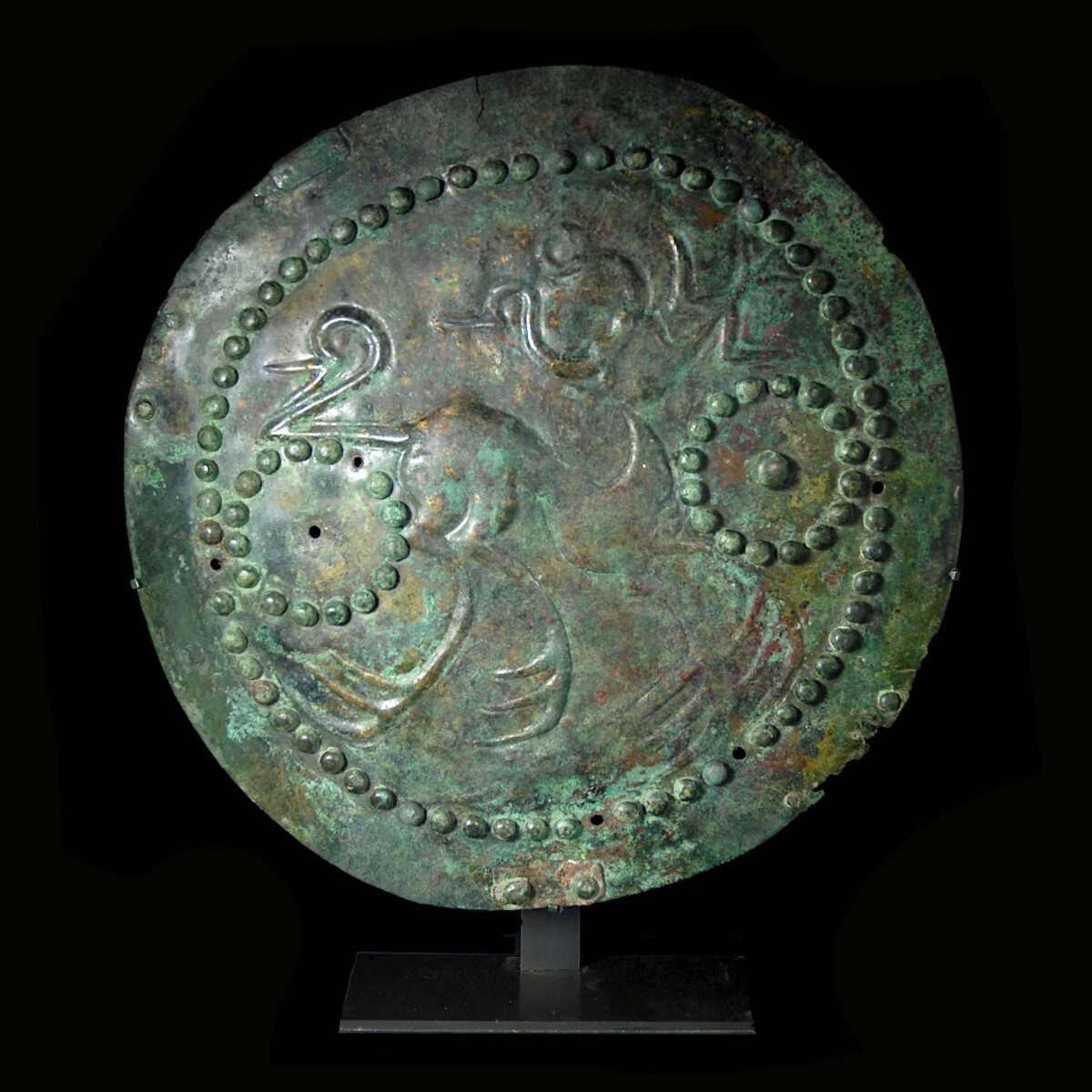
|
|
|
|
Picenum – 6th century B.C.
|
Rare bronze breastplate which belonged to the equipment of a Picentine warrior. The slightly convex, circular plate is hammered and abundantly decorated. In a circle of applied knobs two very creative mixed creatures are cast. The large creature to the left has its head and the body of a water bird, but with four oversize legs with long claws. On the tail rests another stylized animal, which has two heads with long beaks, which rests on a semi-circular neck. A long tail with wing-like extensions protrudes to the right. On the left and right image area two small circles of applied knobs are applied, one with a knob, the other one with a perforation in the centre. Through seven perforations in total the plate was affixed on a leather background. Plates such as the present one were worn as armour to protect the heart, this is why they were also called as kardiophylax. The Picentes were contemporaries of the Etruscans, who settled from the 9th century B.C. in the upper Italian Adriatic coastline in the marches. In 268 B.C. the Romans finally conquered their capital city. See for the way of wearing of a breastplate the depiction of the warrior from Capestrano in the Museo archeologico nazionale d’Abruzzo. A breastplate with similar decoration is in the British Museum with object reference 1872,1008.1. For further parallels, see Christie’s auction on June 10, 2010, lot 121 and the publication “Ancient Art from the Barbier-Mueller Museum”, Geneva 1991, pages 92-93. Mounted.
|
Provenance: Galerie Elsa Bloch-Diener, Bern, Switzerland. From there acquired in the 1970s by Alice and Fernand Halpen. By descent to the collection Jacques and Henriette Schumann. Auctioned with Christie’s Paris on 30 September 2003, lot 85. Last in the English art market.
Dimensions: 25.6 cm in diameter
Price: 12 000 Euro
|
|
|
Picenum – 6. Jahrhundert v. Chr.
|
Seltene Brustplatte aus Bronze, die zur Ausstattung eines picenischen Kriegers gehörte. Die leicht konvexe, kreisrunde Platte ist gehämmert und reich verziert. In einem Kreis aus applizierten Noppen sind zwei überaus kreative Mischwesen ausgetrieben. Das große, nach links gerichtete Wesen hat den Kopf und den Körper eines Wasservogels, jedoch vier übergroße Beine mit langen Krallen. Am Schwanz ruht ein weiteres stilisiertes Tier, das zwei Köpfe mit langen Schnäbeln besitzt, die auf einem halbkreisförmigen Hals aufsitzen. Ein langer Schwanz mit flügelartigen Fortsätzen steht nach rechts ab. In der linken und rechten Bildhälfte sind zwei kleine Kreise aus applizierten Noppen angebracht, einer mit Noppe, der andere mit Lochung in der Mitte. Über insgesamt sieben Lochungen war die Platte an einem ledernen Untergrund fixiert. Scheiben wie diese wurden als Rüstung getragen, um das Herz zu schützen, weshalb sie auch als Kardiophylax bezeichnet werden. Die Picener waren Zeitgenossen der Etrusker, die ab dem 9. Jahrhundert v. Chr. an der oberitalienischen Adriaküste in den Marken siedelten. 268 v. Chr. wird ihre Hauptstadt schließlich von den Römern erobert. Vergleiche zur Tragart einer Brustplatte wie dieser die Darstellung des Kriegers von Capestrano im Museo archeologico nazionale d’Abruzzo. Eine Brustplatte mit ähnlicher Verzierung befindet sich im British Museum mit der Objektreferenz 1872,1008.1. Weitere Parallelen siehe Christie’s Auktion vom 10. Juni 2010, Los 121 sowie die Publikation „Ancient Art from the Barbier-Mueller Museum“, Genf 1991, Seite 92-93. Gesockelt.
|
Provenienz: Galerie Elsa Bloch-Diener, Bern. Dort in den 1970er Jahren von Alice und Fernand Halpen erworben. Durch Erbe an die Sammlung Jacques und Henriette Schumann. Versteigert bei Christie’s Paris am 30. September 2003, Los 85. Zuletzt im englischen Kunsthandel.
Durchmesser: 25,6 cm
Preis: 12.000 Euro
|
|
|
|
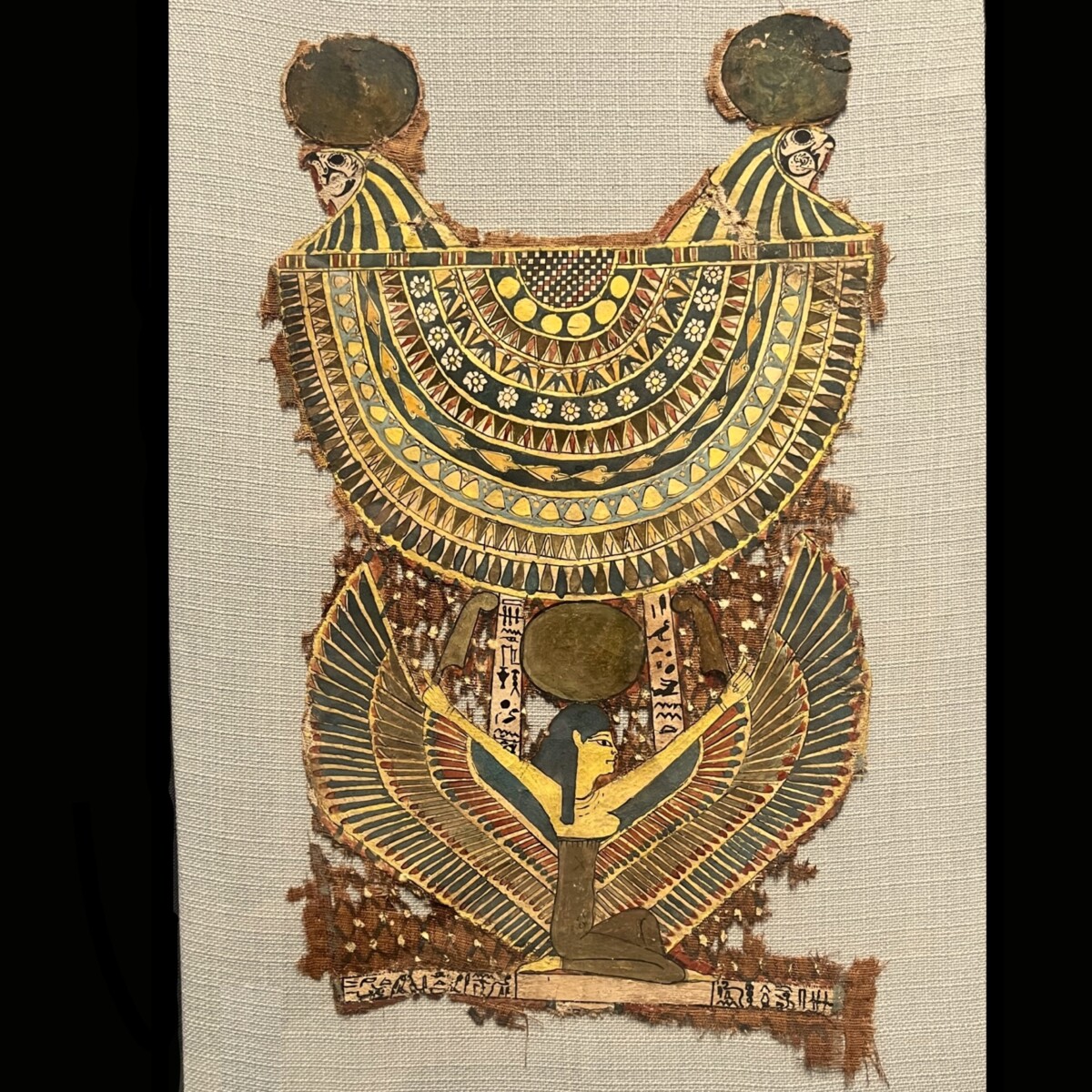
|
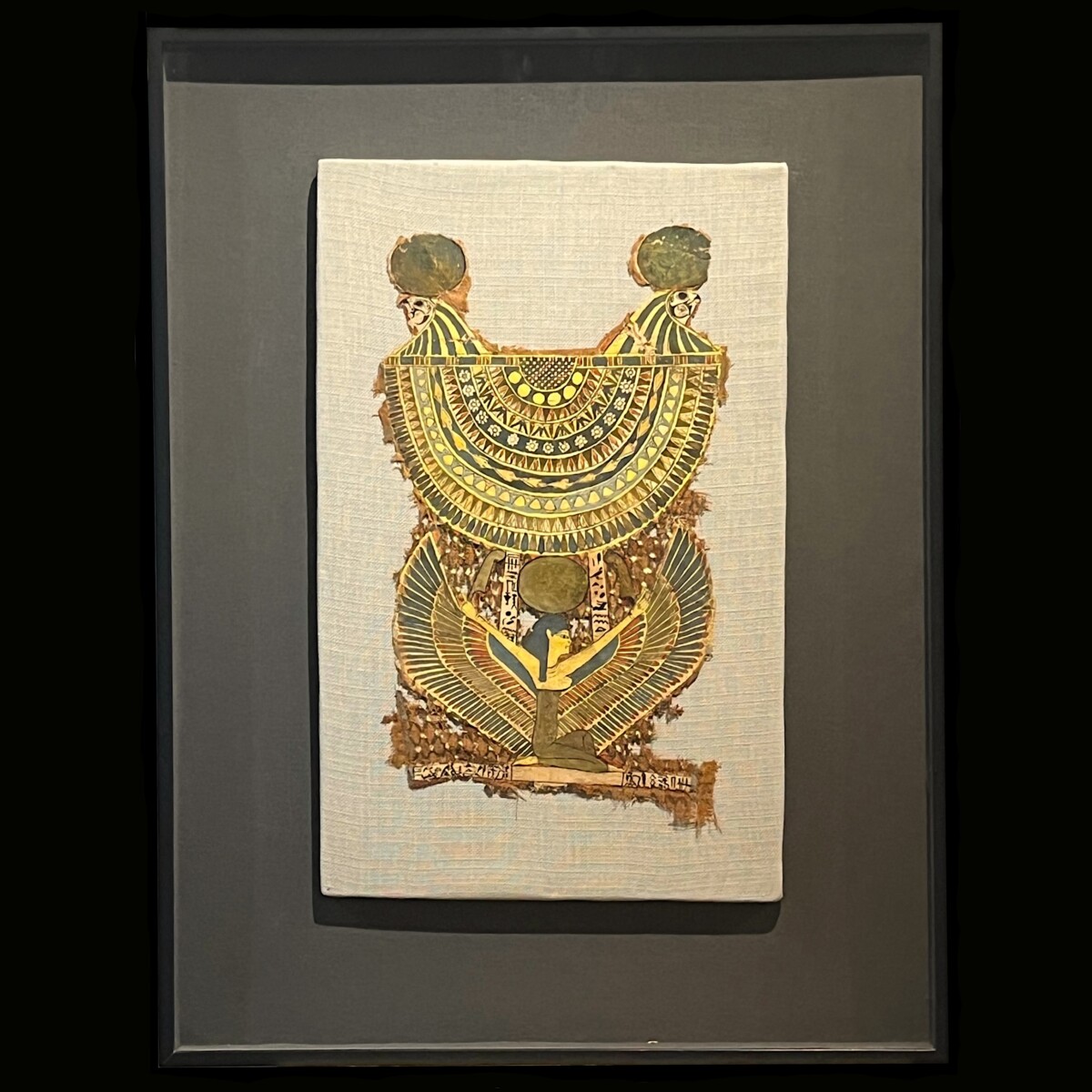
|
|
|
|
Egypt – Ptolemaic period, 332-30 B.C.
|
Particularly high-quality and richly painted chest piece from a mummy cartonnage made of linen. The upper part is formed by two falcon heads with sun discs facing outwards. Below a nine-row, magnificently crafted collar (“usekh”) with rows of lotus blossoms, rosettes and circles. The end is formed by a hem of teardrop pearls. Below the collar the goddess Isis with sun disk kneels facing to the right. Her wings are wide open, and she holds in each hand an ostrich feather of the atef crown, her husband Osiris’ symbol of power. Above her are two vertical columns with hieroglyphs. The inscription reads: “Words are spoken by the daughter of Re, who lives protected by Osiris and her heart rejoices.” Below the goddess a light bar with two more inscriptions. They read: “Words spoken by Hapy”, as well as “Words spoken by Imsety”. The text is about two of the four sons of Horus, who protected the intestines of the deceased. The cartonnage is mounted on a canvas and framed behind glass for suspension on the wall.
|
Provenance: French private collection Jean Deriat (1922-2016), acquired on 2 June 2012 from gallery Olivier Tiano "HIER et AILLEURS" in Paris. With the original invoice. Thence in a family estate. Accompanied by a French antiquities passport.
Dimensions: 40.2 cm high (cartonnage); 70 cm x 53.3 cm (dimensions of the frame)
|
|
|
Ägypten – Ptolemäische Zeit, 332-30 v. Chr.
|
Besonders hochwertig gearbeitetes und reich bemaltes Bruststück einer Mumienkartonage aus Leinen. Den oberen Abschluss bilden zwei nach außen blickende Falkenköpfe mit Sonnenscheibe. Darunter ein neunreihiger, prachtvoll gestalteter Halskragen („Wesech“) mit Reihen von Lotusblüten, Rosetten und Kreisen. Den Abschluss bildet ein Saum aus Tropfenperlen. Unter dem Halskragen kniet die Göttin Isis mit Sonnenscheibe nach rechts. Sie hat ihre Flügel weit geöffnet und hält eine Straußenfeder der Atefkrone, dem Herrschaftszeichen ihres Gatten Osiris, in jeder Hand. Über ihr sind zwei vertikale Kolumnen mit Hieroglyphen. Die Inschrift lautet: „Worte gesprochen von der Tochter des Re, die im Schutz von Osiris lebt und deren Herz jubelt.“ Unter der Göttin eine helle Leiste mit zwei weiteren Inschriften. Sie lauten: „Worte gesprochen von Hapi“ sowie „Worte gesprochen von Amset“. Es handelt sich um zwei der vier Söhne des Horus, die die Eingeweide des Verstorbenen beschützten. Die Kartonage ist auf einer Leinwand aufgebracht und hinter Glas zur Hängung an der Wand gerahmt.
|
Provenienz: Französische Privatsammlung Jean Deriat (1922-2016), erworben am 2. Juni 2012 bei Galerie Olivier Tiano „HIER et AILLEURS“ in Paris. Mit Original-Rechnung. Danach in Familienbesitz. Mit französischem Antikenpass.
Höhe Kartonage: 40,2 cm; Dimensionen Rahmen: 70 cm x 53,3 cm
Preis: 6.000 Euro
|
|
|
|
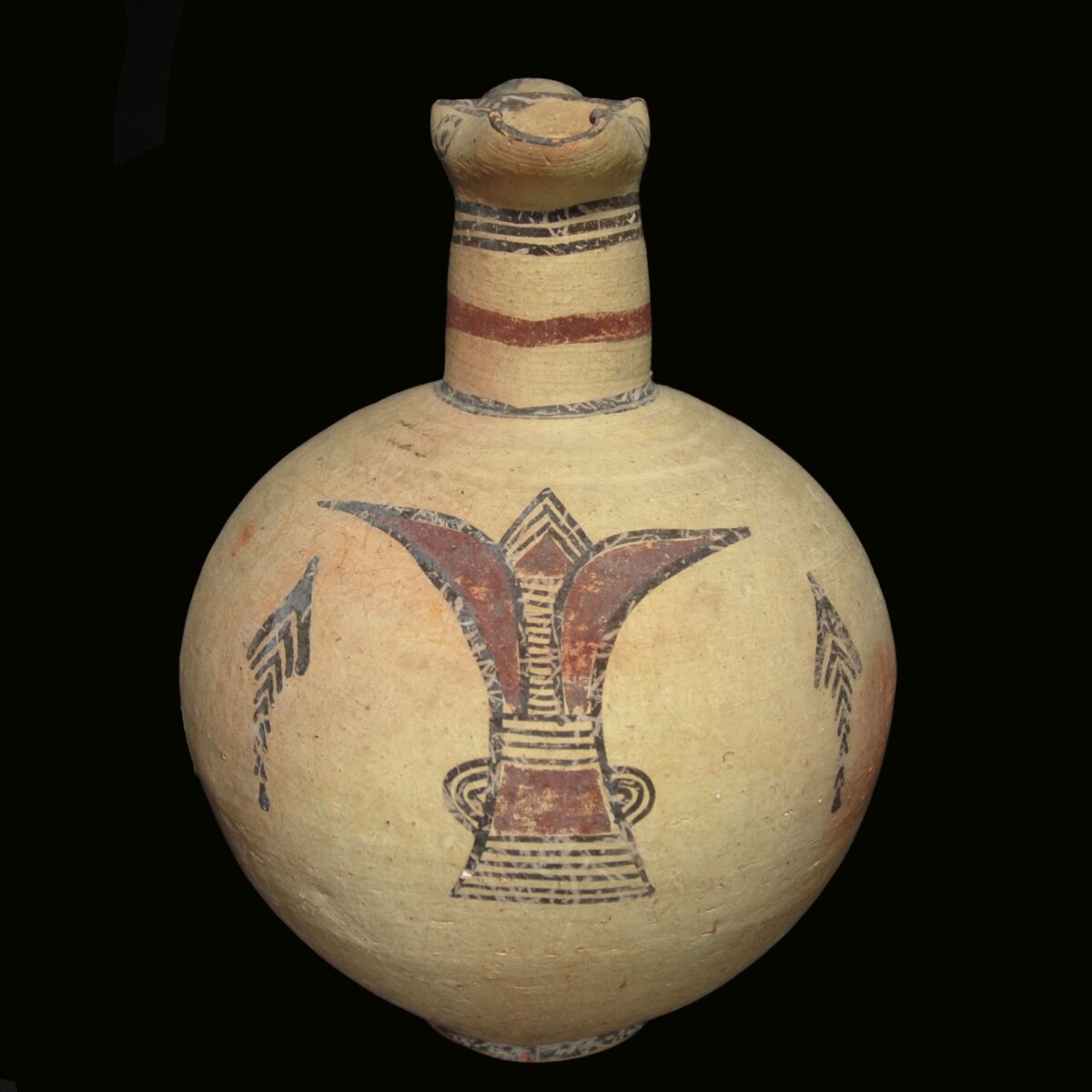
|
|
|
|
|
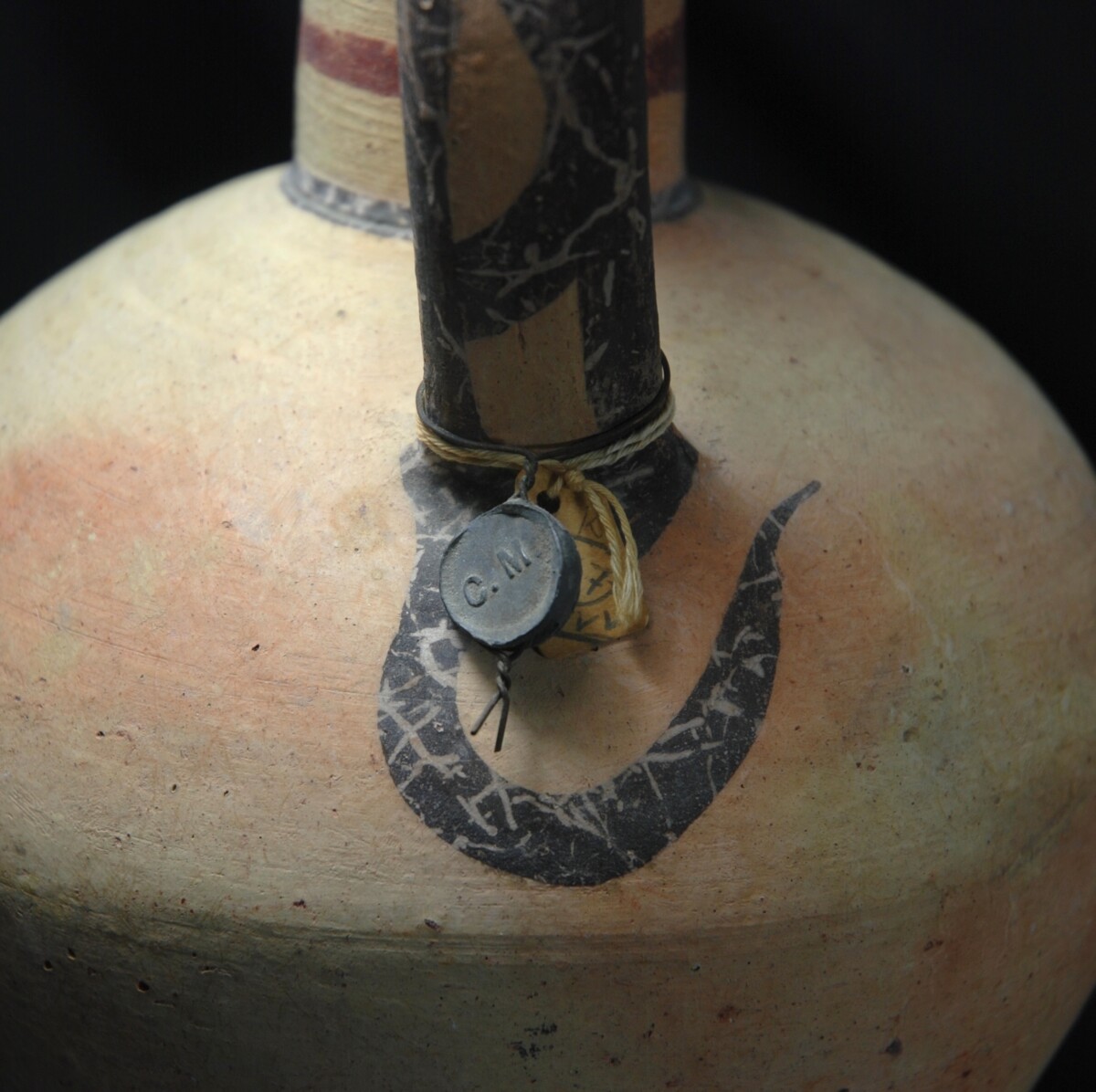
|
Wonderfully preserved Cypriot jug of the Bichrome-Ware dating to Cyprus’ archaic period. The painting in red and black color depicts a tapering, stylized lotus blossom with red leaves turning outwards. The plant is on the sides framed by two arrows pointing upwards. Around the neck red and black bands. The jug itself has a spherical corpus, which stands on a set off foot ring. On the curved cloverleaf spout, which also reminds of a bird’s head, two eyes are painted on each side. The handle starts at the back on the spout and reaches to the shoulder. It is painted with an S-shaped serpent, whose tails swings out on the corpus. With an official Cypriot lead export seal and an old collection label on the handle. See for the depiction of the lotus blossom the jugs in the Metropolitan Museum with the inventory number 74.51.517 and in the Penn Museum with the object number MS5711.
|
Provenance: From the private collection of the art historian Richard Brilliant, New York, acquired in the 1960s. With the Cypriot export seal.
Dimensions: 22.8 cm high
Price: 6 000 Euro
|
|
Wunderbar erhaltene zypriotische Kanne der Bichrome-Ware aus der archaischen Zeit Zyperns. Die Bemalung in roter und schwarzer Farbe zeigt eine spitz zulaufende, stilisierte Lotusblüte mit roten, nach außen gebogenen Blättern. Die Pflanze wird seitlich von zwei nach oben zeigenden Pfeilen flankiert. Um den Hals rote und schwarze Bänder. Die Kanne selbst hat einen kugelförmigen Korpus, der auf einem leicht abgesetzten Standring steht. Auf dem geschwungenen Kleeblattausguss, der ebenfalls an einen Vogelkopf erinnert, sind seitlich je zwei Augen aufgemalt. Der Henkel setzt hinten am Ausguss an und reicht bis zur Schulter. Er ist mit einer s-förmigen Schlange bemalt, deren Schwanz am Korpus ausschwingt. Mit offizieller zypriotischer Exportplombe aus Blei und einem alten Sammlungsetikett am Henkel. Vergleiche zur Darstellung der Lotusblüte die Fasskannen im Metropolitan Museum mit der Inventarnummer 74.51.517 und im Penn Museum mit der Objektnummer MS5711.
|
Provenienz: Aus der Privatsammlung des Kunsthistorikers Richard Brilliant, New York, erworben in den 1960er Jahren. Mit zypriotischer Exportplombe.
Höhe: 22,8 cm
Preis: 6.000 Euro
|
|
|
|
|
|
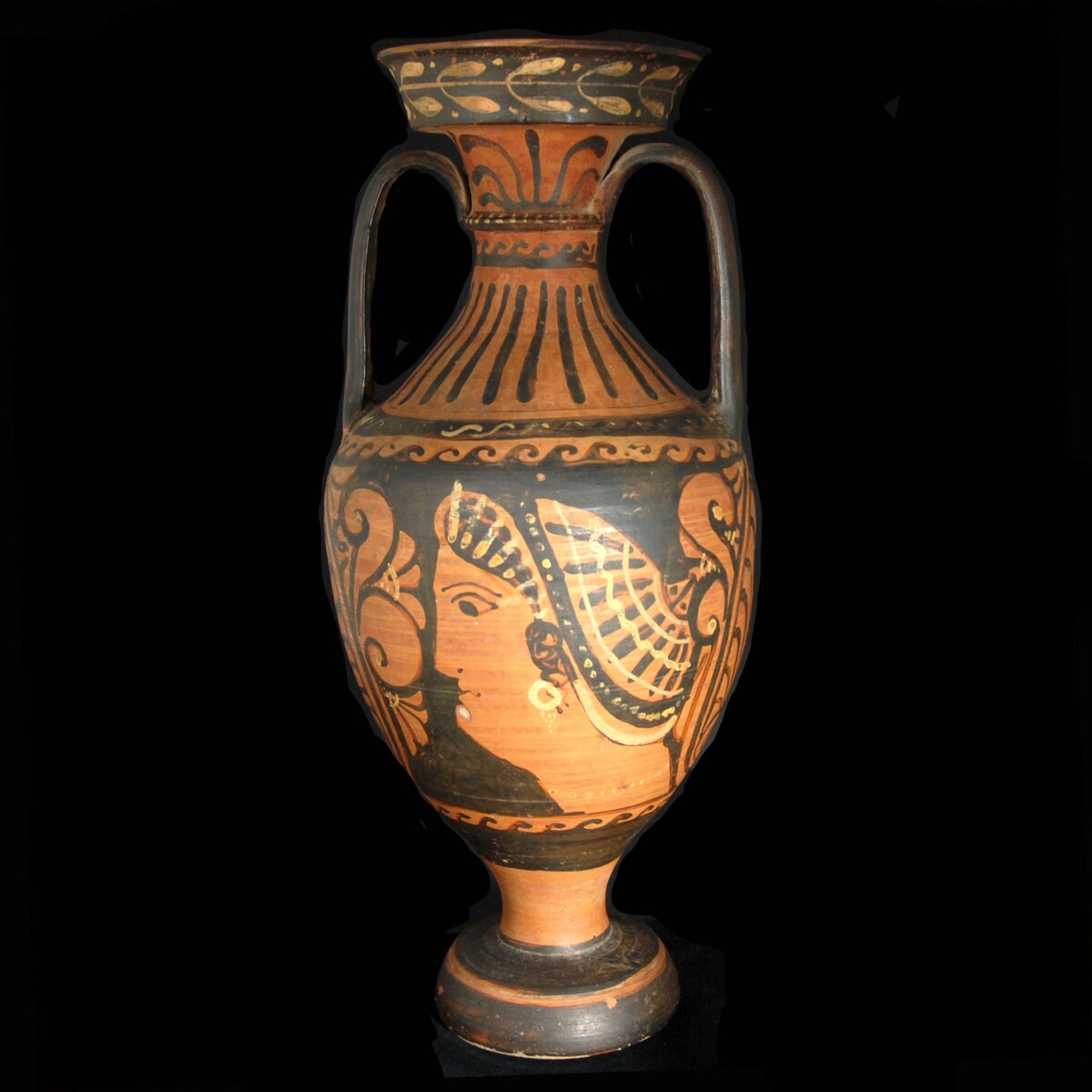
|

|
|
Greece/Apulia – 320-300 B.C.
|
Large red-figure amphora with a woman's portrait on both sides. The so-called "Ladies of Fashion" each facing to the left. The women wear a stephane over the forehead and an abundantly adorned sakkos on the back of the head. Earrings and necklaces are applied in opaque white. Below the handles rich palmette decoration. The bottom end is formed by a wavy band. On top on one side meander in white, on the other side white and black wavy band. On the neck long, black tongues and another wavy band. The handles start on a small set off rib on the neck. The estuary pulled outwards, outside on the broad rim encircling laurel leaves in white.
|
Provenance: English private collection, acquired prior to 2000.
Dimensions: 41.8 cm high
Price: 6 000 Euro
|
|
|
Griechenland/Apulien – 320-300 v. Chr.
|
Große rotfigurige Amphora mit Frauenporträts auf beiden Seiten. Diese sogenannten „Ladies of Fashion“ blicken jeweils im Profil nach links. Die Frauen tragen eine Stephane über der Stirn und einen reich geschmückten Sakkos am Hinterkopf. Ohrringe und Halsketten sind in Deckweiß aufgetragen. Unter den Henkeln dichte Palmetten-Dekoration. Den unteren Abschluss bildet ein Wellenband. Oben auf der einen Seite Mäander in Weiß, auf der anderen weißes und schwarzes Wellenband. Am Hals lange schwarze Zungen und ein weiteres Wellenband. An einer kleinen abgesetzten Rippe am Hals setzen die Henkel an. Die Mündung nach außen gezogen, am breiten Rand außen umlaufende Lorbeerblätter in Weiß.
|
Provenienz: Englische Privatsammlung, erworben vor 2000.
Höhe: 41,8 cm
Preis: 6.000 Euro
|
|
|
|
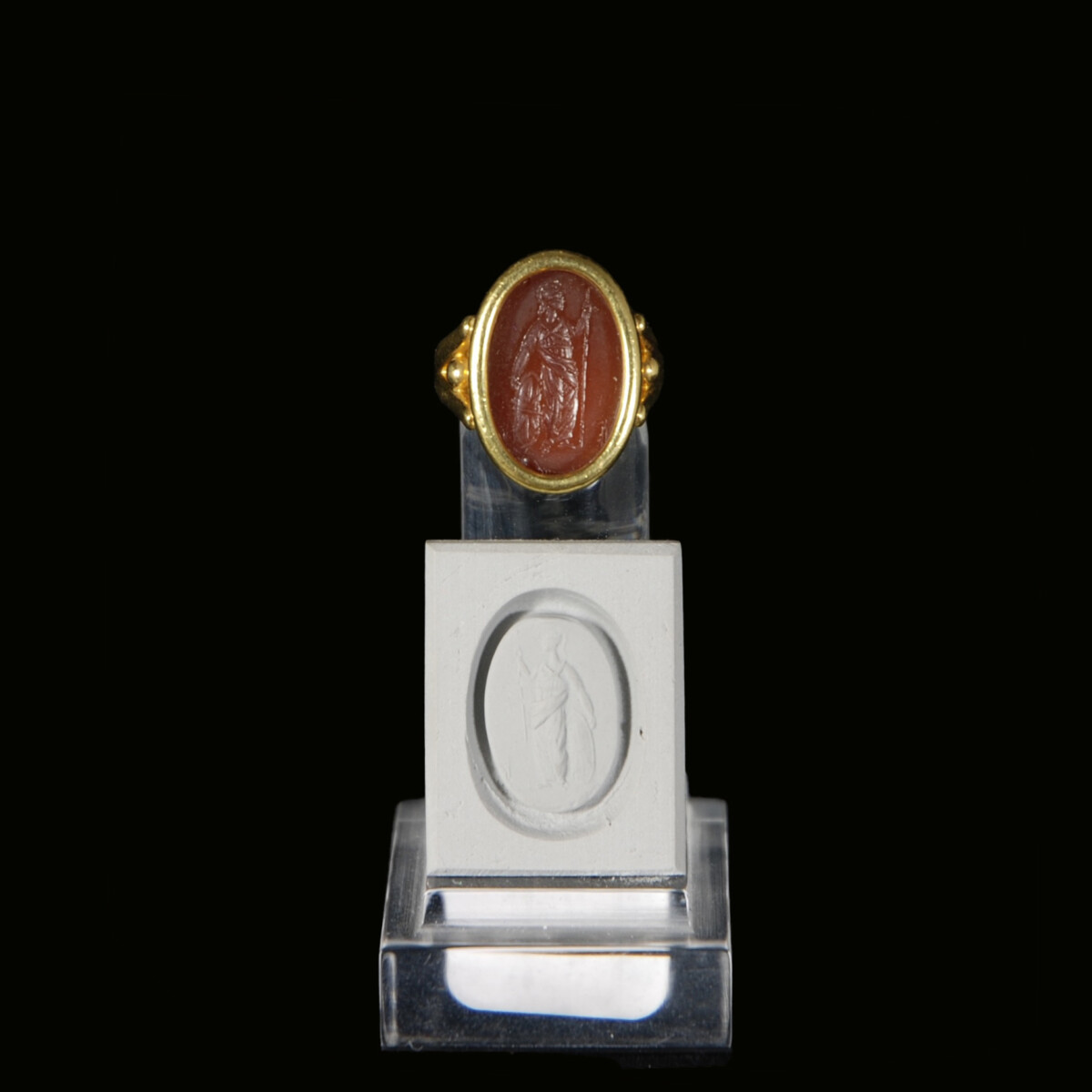
|
|
|
|
|
|
Roman Empire – 2nd century A.D.
|
Modern 18 carat gold ring with an open work ring setting and a massive bezel, where a Roman intaglio is set. The intaglio is of red agate depicting Minerva to the right. The goddess presents herself in the type of “Athena Parthenos”. She leans on the lance with her raised left hand and holds the shield next to her with her lowered right hand. Minerva wears an attic helmet with a high crest. The most famous statue of Zeus’ daughter, to which this intaglio image from Roman times can be traced back, is certainly the colossal cult image made of gold and ivory created by Phidias, which stood in the Parthenon on the Athenian Acropolis. Ready to wear. With base and seal impression of the intaglio.
|
Provenance: From an old New York private collection. Thence in the inventory of the liquidated gallery Fortuna Fine Arts.
Dimensions: 1.6 cm in diameter; 50 (ring size Europe); 13.4 gram
Price: 2 800 Euro
|
|
|
Römisches Reich – 2. Jahrhundert n. Chr.
|
Moderner 18-Karat-Goldring mit durchbrochen gearbeiteter Ringschiene und massiver Fassung, in die eine römische Gemme eingesetzt wurde. Die Gemme aus rotem Achat zeigt Minerva nach rechts. Die Göttin präsentiert sich im Typus der „Athena Parthenos“. Sie stützt sich mit der erhobenen linken Hand auf die Lanze, mit der abgesenkten rechten Hand hält sie den neben ihr stehenden Schild. Minerva trägt einen attischen Helm mit hohem Helmbusch. Die berühmteste Statue der Zeus-Tochter, auf die auch dieses Gemmenbild aus römischer Zeit zurückgeführt werden kann, ist sicherlich das von Phidias geschaffene kolossale Kultbild aus Gold und Elfenbein, das im Parthenon auf der Athener Akropolis stand. Sofort tragbar. Mit Stand und Abdruck der Gemme.
|
Provenienz: Aus alter New Yorker Privatsammlung. Danach im Bestand der aufgelösten Galerie Fortuna Fine Arts.
Durchmesser innen: 1,6 cm; Ringgröße Europa: 50; Gewicht: 13,4 Gramm
Preis: 2.800 Euro
|
|
|
|
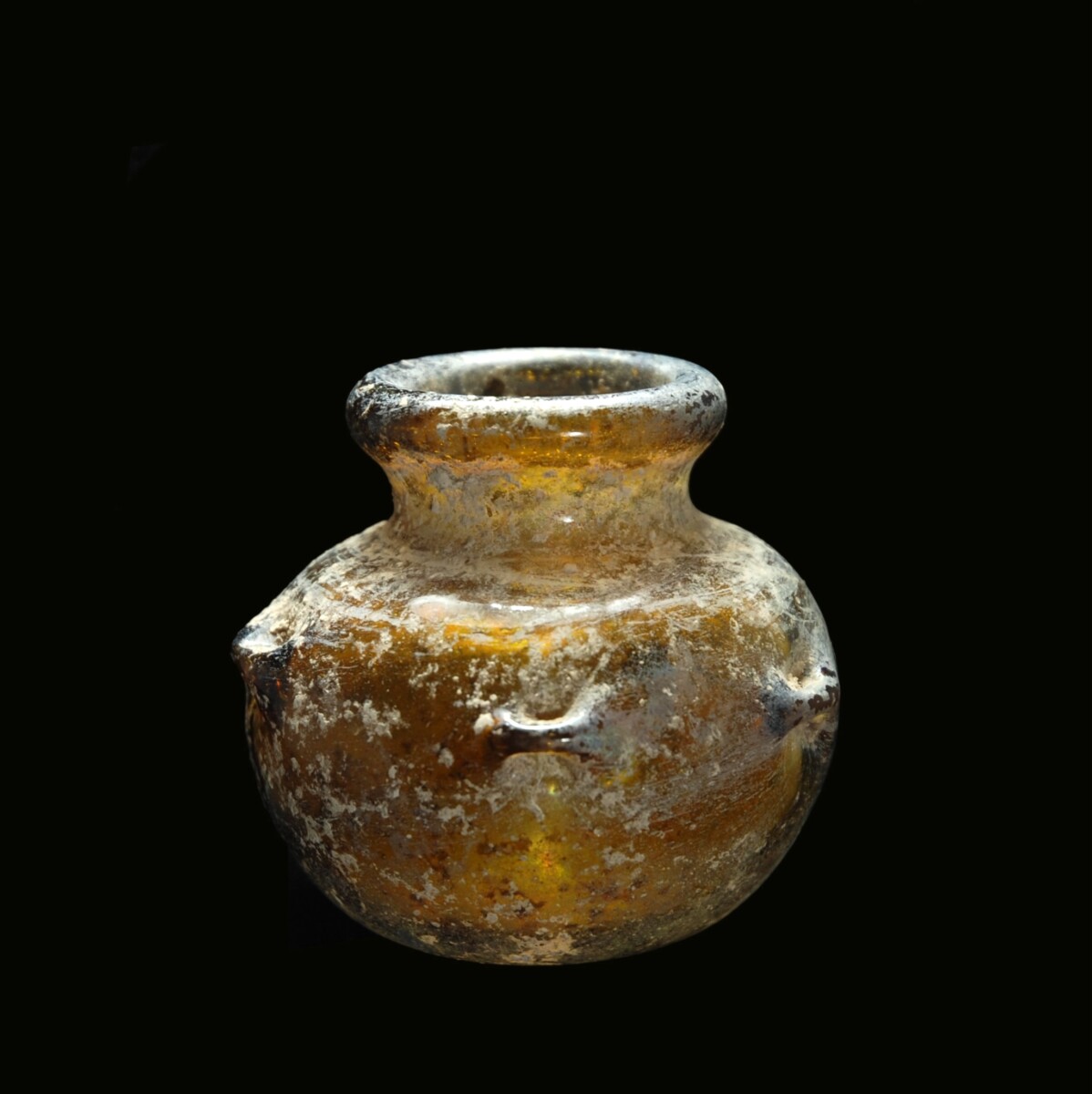
|
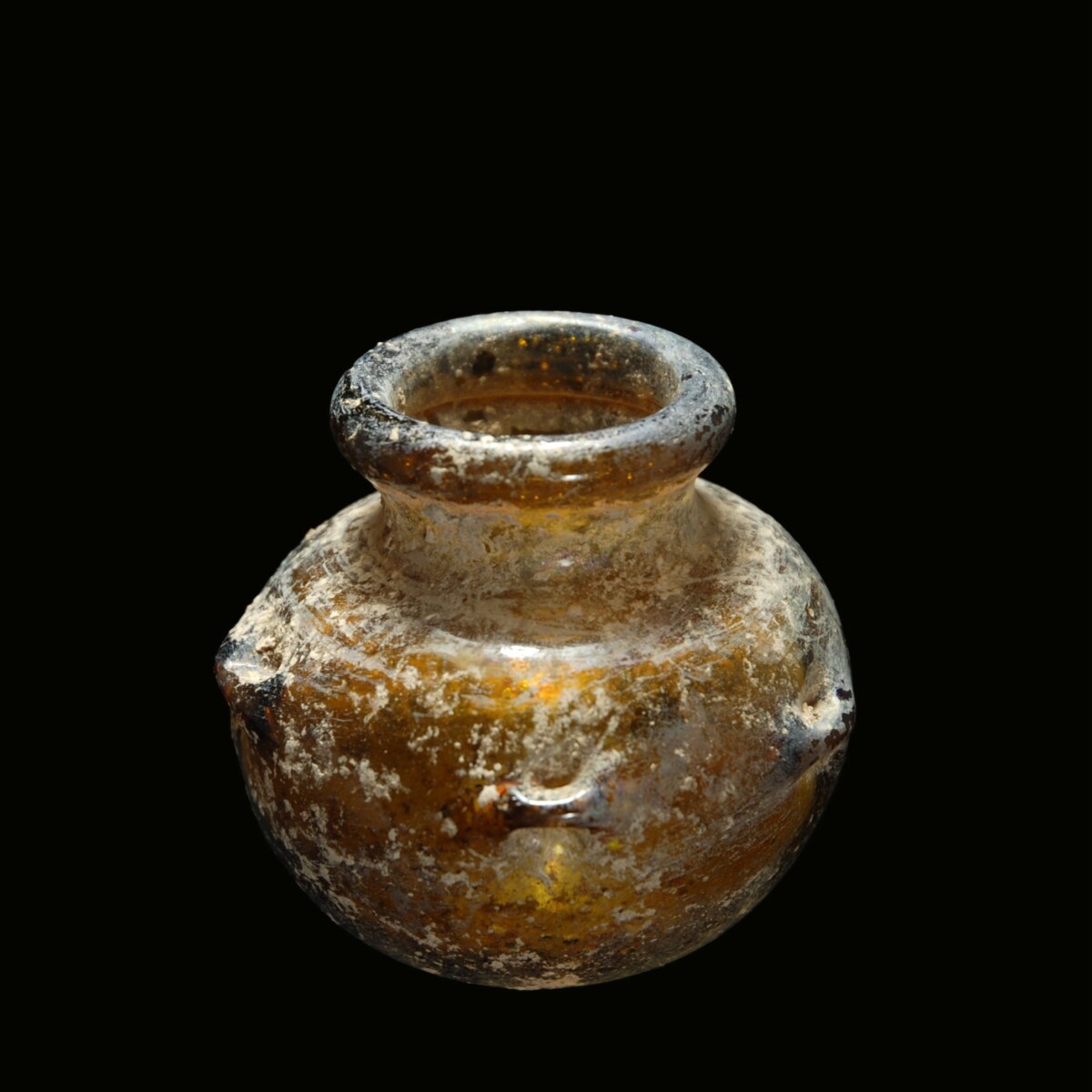
|
|
Roman Empire – 4th century A.D.
|
Charming small pot of amber colored clear glass, which possibly once was used as an ink bottle. The bulbous vessel stands on its indented base and has a short concave neck. The corpus is decorated with five horizontal ribs, which were pulled out with pliers from the wall. The massive round rim is turned inward and thickened. With beautiful iridescence.
|
Provenance: Private collection Arieh Klein, Jerusalem, Israel. Thence in the Israeli art market.
Dimensions: 6.5 cm high; 7 cm in diameter
Price: 900 Euro
|
|
|
Römisches Reich – 4. Jahrhundert n. Chr.
|
Reizvolles Töpfchen aus bernsteinfarbenem Klarglass, das wohl einst als Tintenfässchen Verwendung fand. Das bauchige Gefäß steht auf seiner nach innen gewölbten Basis und hat einen kurzen konkaven Hals. Der Korpus ist mit fünf horizontalen Rippen verziert, die mit der Zange aus der Wandung gezwickt wurden. Der massive runde Rand ist nach innen umgeschlagen und heiß verdickt. Mit schöner Irisierung.
|
Provenienz: Aus der französischen Privatsammlung M. R, erworben in den frühen 1980er Jahren.
Höhe: 6,5 cm; Durchmesser: 7 cm
Preis: 900 Euro
|
|
|
|
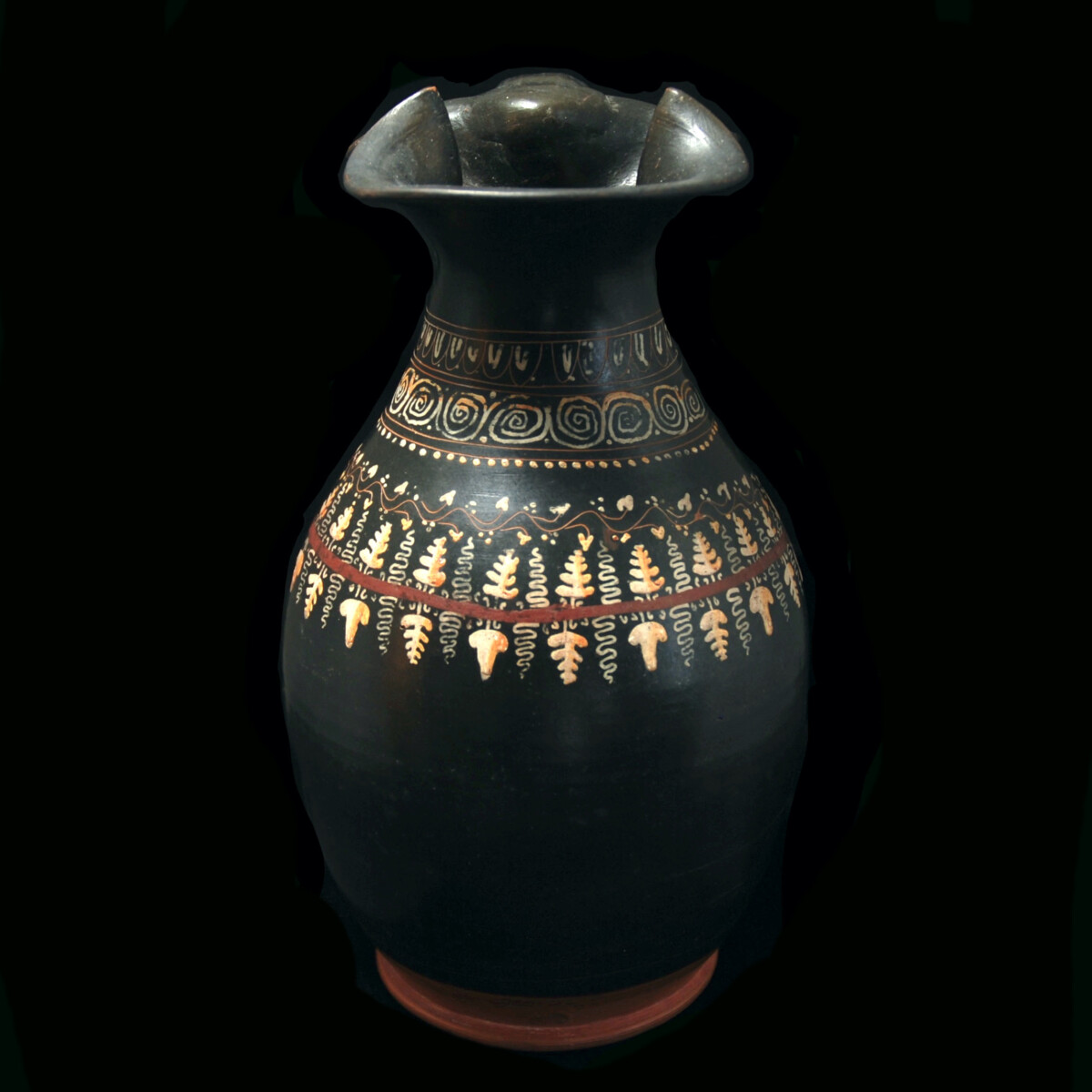
|
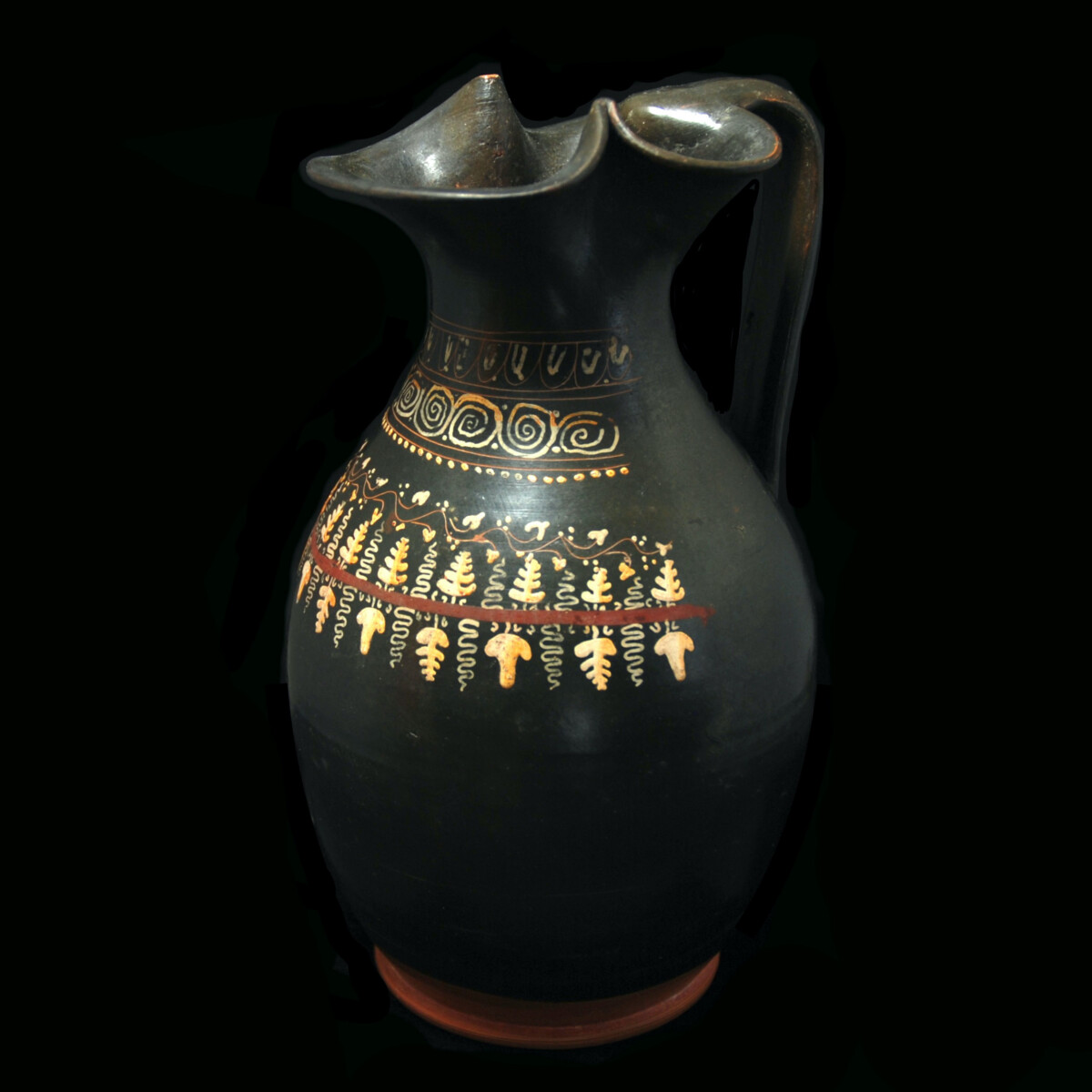
|
|
Greece/Gnathia – 4th century B.C.
|
Large, perfectly preserved trefoil jug with the black varnish typical for the Apulian Gnathia ware and white, yellow as well as red paint. Below the spout five registers are painted in a semicircle. On top white egg-and-dart between double incised lines. Followed by a volute band and dotted decoration in white. Then followed by an ivy tendrils with incised decoration. Last two large bands of wine tendrils. The foot ring is slightly set off and not painted.
|
Provenance: From an old German collection, acquired in the 1950s to 1960s.
Dimensions: 25 cm high
Price: 2 800 Euro
|
|
|
Griechenland/Gnathia – 4. Jahrhundert v. Chr.
|
Große, perfekt erhaltene Kleeblattkanne mit dem für die apulische Gnathia-Ware typischen schwarzen Firnis und weißer, gelber sowie roter Bemalung. Unter dem Ausguss sind im Halbkreis fünf Register aufgemalt. Oben weißer Eierstab zwischen doppelten Ritzlinien. Danach ein Volutenband und Punktdekor in Weiß. Anschließend eine Efeuranke mit Ritzdekor. Zuletzt zwei große Bänder Weinranken. Der Standring ist leicht abgesetzt und nicht bemalt.
|
Provenienz: Aus einer alten deutschen Sammlung, erworben in den 1950er und 1960er Jahren.
Höhe: 25 cm
Preis: 2.800 Euro
|
|
|
|
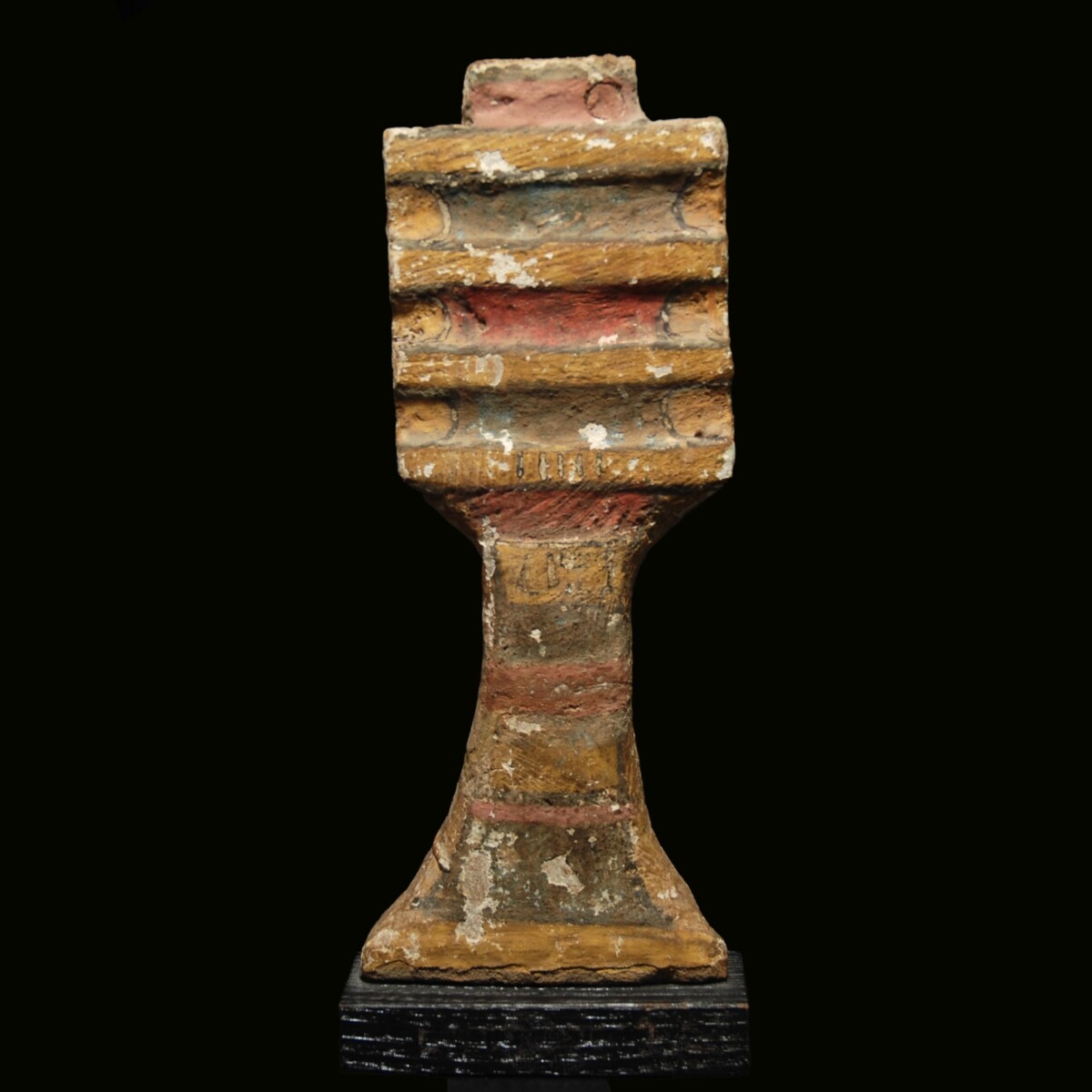
|
|
|
|
Egypt – Late period, 664-332 B.C.
|
Large wood djed pillar with abundant, polychromic painting. The pillar is far protruding at the bottom. Around the centre a hardly readable hieroglyphic inscription which mentiones the name of the owner. The djed pillar was one of the most used amulets in Egypt. It is considered as the symbol for “endurance” and “eternity”. From the New Kingdom on, due to its form, it was also associated as the backbone of god Osiris. It should connect the deceased with Osiris, who was brought back to life after his death. On top a preserved wood tenon which was used to affix the very large djed pillar to a furniture in the tomb or to a sarcophagus.
|
Provenance: Belgian private collection Félix Lauwers (1928-1995), acquired in the 1970s. Thence auctioned with Pierre Bergé in Paris on 30 November 2011, lot 373. There acquired by the private collection of Jean Deriat (1922-2016), thence in a family estate.
Dimensions: 22.4 cm high
Price: 2 800 Euro
|
|
|
Ägypten – Spätzeit, 664-332 v. Chr.
|
Großer Djed-Pfeiler aus Holz mit reich erhaltener, polychromer Bemalung. Der Pfeiler unten weit auslaufend. Etwa in der Mitte eine schwer lesbare Hieroglyphen-Inschrift, die den Namen des Besitzers nennt. Der Djed-Pfeiler war eines der am häufigsten benutzten Amulette in Ägypten. Er gilt als Symbol für „Dauer“ und „Ewigkeit“. Ab dem Neuen Reich wurde er aufgrund seiner Form auch mit dem Rückgrat des Gottes Osiris assoziiert. Das sollte den Verstorbenen mit Osiris in Verbindung bringen, der nach seinem Tod wieder zum Leben erweckt wurde. Oben ein erhaltener Holznagel, mit dem der sehr große Djed-Pfeiler vielleicht an einem Möbel im Grab oder am Sarkophag befestigt wurde. Auf altem Holzsockel.
|
Provenienz: Belgische Privatsammlung Félix Lauwers (1928-1995), erworben in den 1970er Jahren. Danach versteigert bei Pierre Bergé Auctions in Paris am 30. November 2011, Los 373. Dort erworben von der Privatsammlung Jean Deriat (1922-2016), danach in Familienbesitz.
Höhe: 22,4 cm
Preis: 2.800 Euro
|
|
|
|
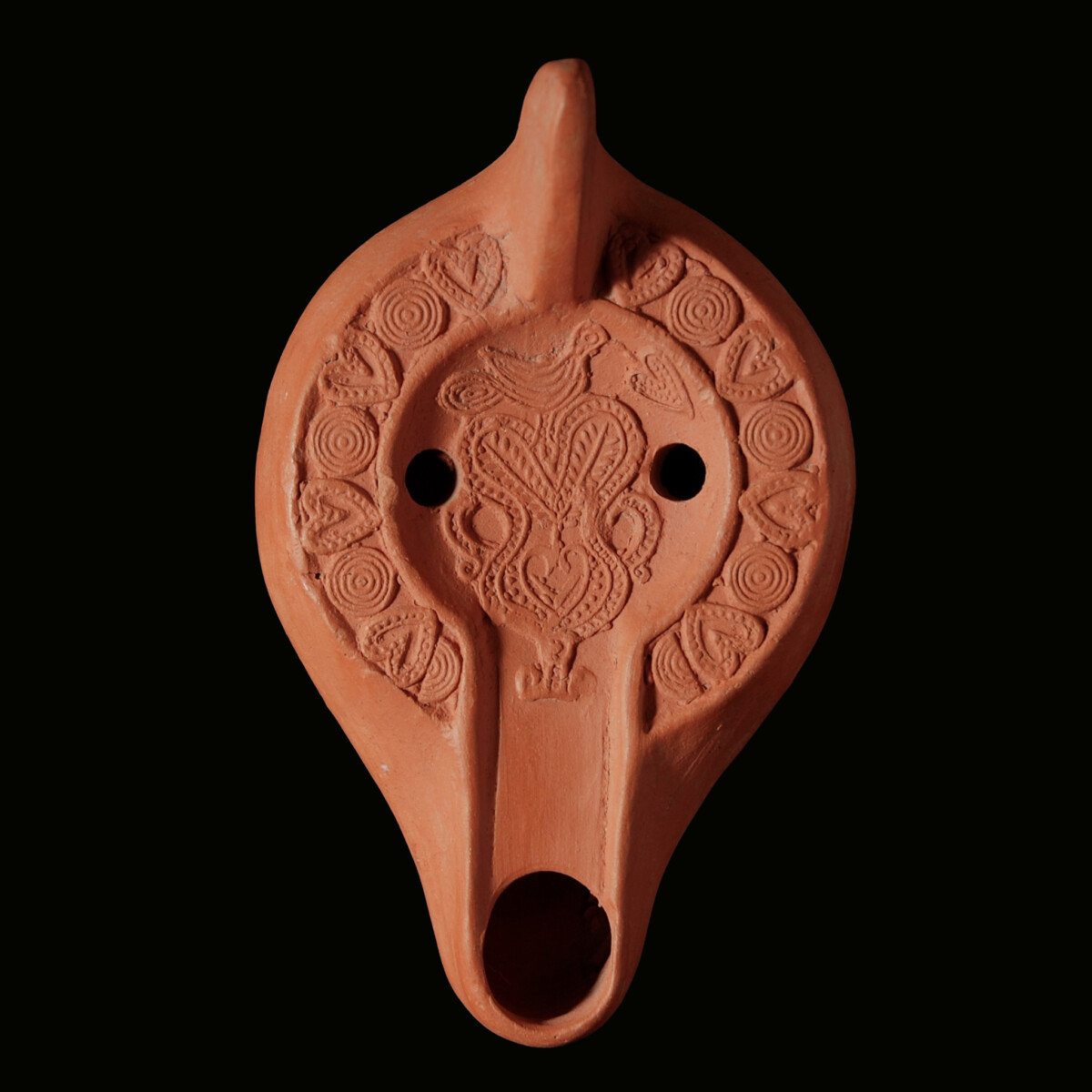
|
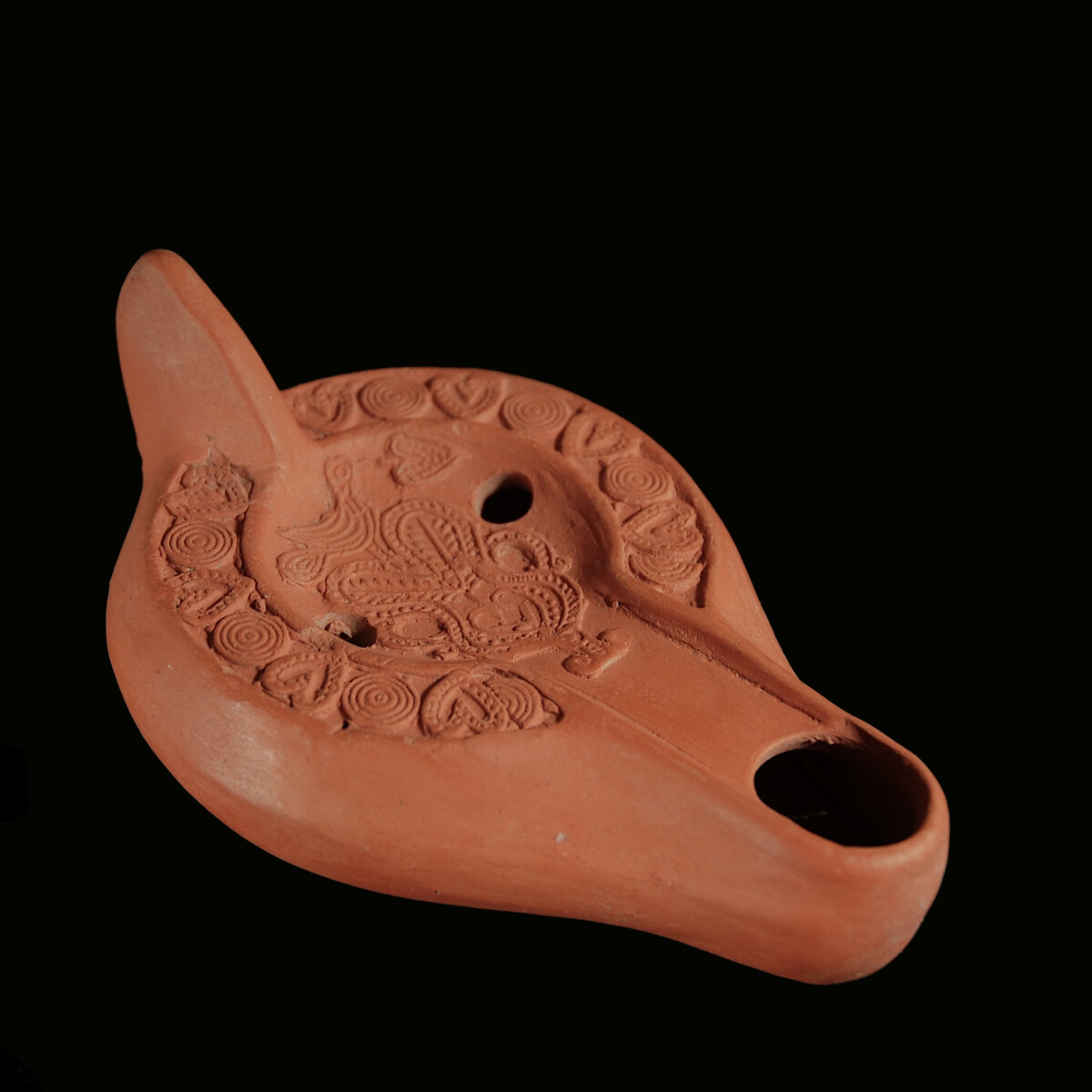
|
|
Roman Empire/North Africa – 4th-5th century A.D.
|
Large early Christian oil lamp of the so-called "Red Slip Ware", which was manufactured in late Roman North Africa, probably in today's Tunisia. The long snout with an oval venting hole. In the slightly deepened mirror two pouring holes, in between an amphora on a high foot with a spherical corpus. In the abundantly decorated vase is a heart-shaped seed, from where a plant with large leaves blossoms. In between the leaves sits a pigeon to the right with a heart-shaped leaf in the beak. The shoulder of the lamp is decorated with concentric circles and more dotted, heart-shaped leaves. At the back a rounded tenon for transportation. The lamp stands on a raised foot ring, with two finely engraved concentric circles in the centre.
|
Provenance: Belgian private collection, acquired on 17 June 2006 from André de Munter Archeologie in Brussels, Belgium. With the original certificate signed by André de Munter. On the back of the certificate is a label with the stamp of a court inspection dated 26 June 2009 with the signature of the law clerk F. Coene N.
Dimensions: 13.2 cm long
Price: 800 Euro
|
|
|
Römisches Reich/Nordafrika – 4.-5. Jahrhundert n. Chr.
|
Große frühchristliche Öllampe der sogenannten „Red Slip Ware“, die im spätrömischen Nordafrika, wohl im heutigen Tunesien, hergestellt wurde. Die lange Schnauze mit ovalem Brennloch. Im leicht vertieften Spiegel zwei Einfülllöcher, dazwischen eine Amphore auf hohem Fuß mit kugeligem Korpus. In der mit Punkten reich verzierten Vase befindet sich ein herzförmiger Kern, aus dem eine Pflanze mit großen Blättern erwächst. In den Blättern sitzt eine Taube nach rechts und hält wiederum ein herzförmiges Blatt im Schnabel. Die Schulter der Lampe ist mit konzentrischen Kreisen und weiteren gepunkteten, herzförmigen Blättern dekoriert. Hinten ein abgerundeter Zapfen zum Tragen. Die Lampe steht auf einem erhabenen Fußring, in dessen Mitte zwei fein gravierte konzentrische Kreise.
|
Provenienz: Belgische Privatsammlung, erworben am 17. Juni 2006 bei André de Munter Archeologie in Brüssel. Mit Original-Zertifikat unterschrieben von André de Munter. Auf der Rückseite des Zertifikats ein Aufkleber mit Stempel einer Gerichtsbeschau vom 26. Juni 2009 mit der Unterschrift des Gerichtsschreibers F. Coene N.
Länge: 13,2 cm
Preis: 800 Euro
|
|
|
|
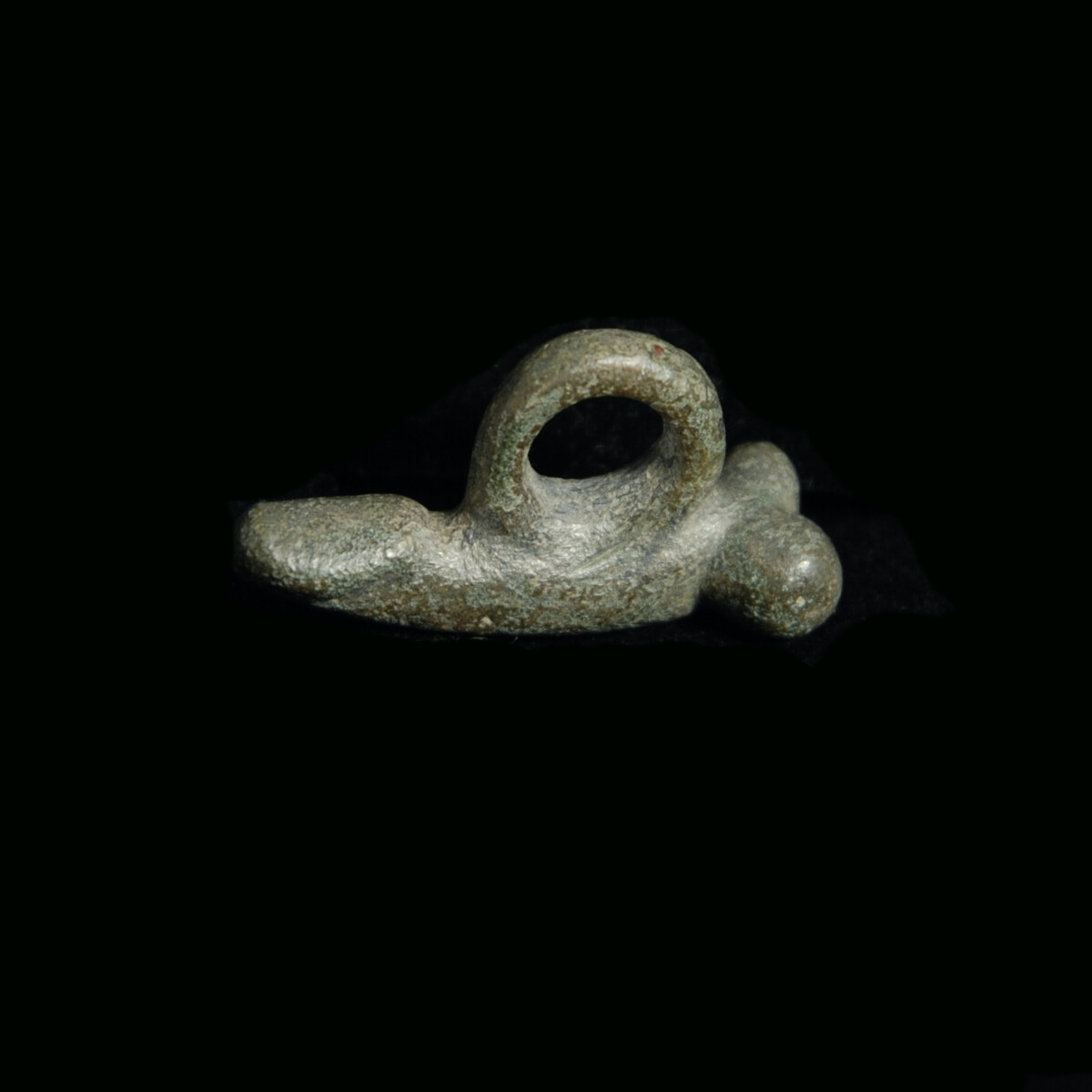
|
|
|
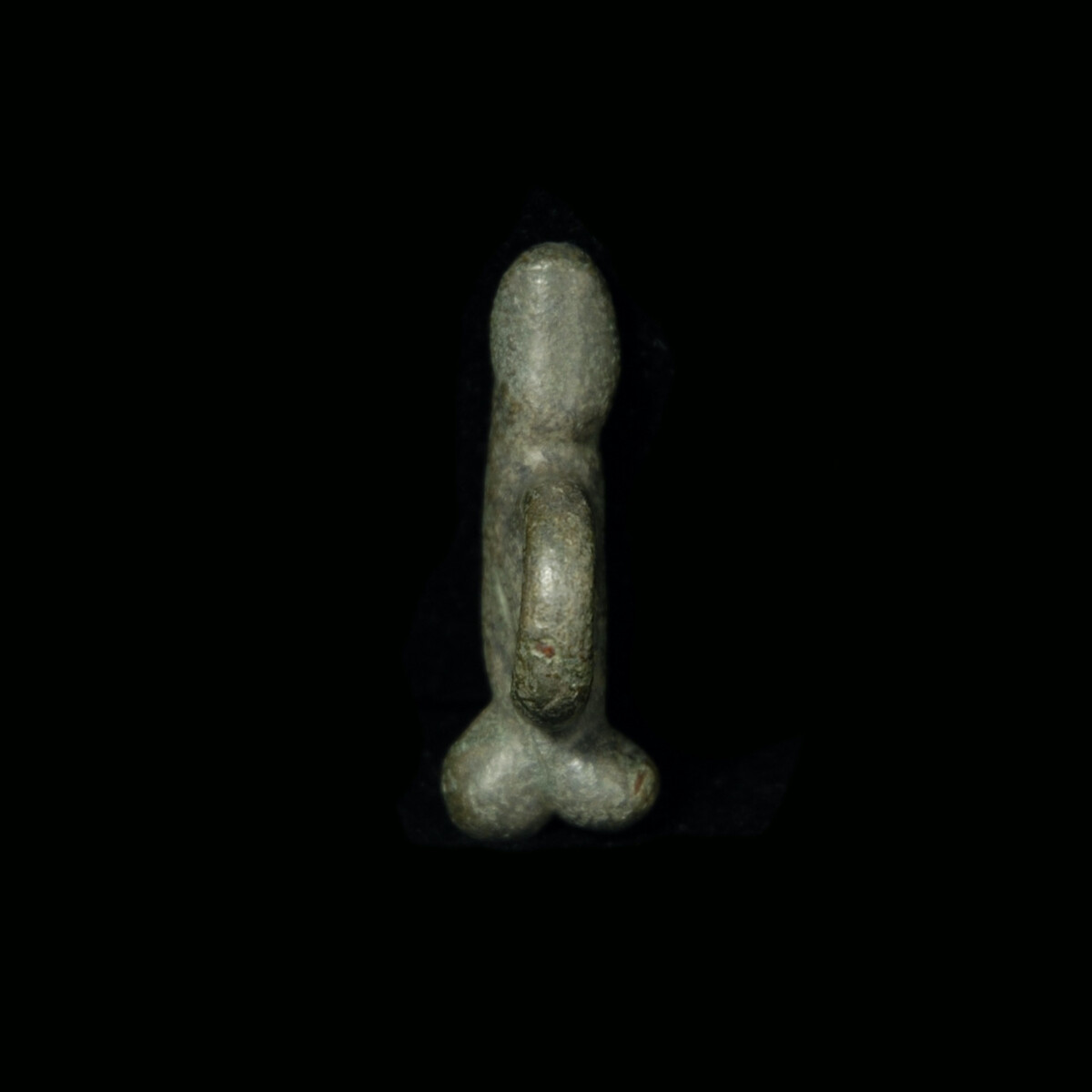
|
|
Roman Empire – 2nd century A.D.
|
Massive cast and heavy bronze amulet in form of a phallus (“fascinum”) worked out in fine quality. On the sides the protruding, spherical scrotum. On the upper side a large, circular eyelet for suspension. The end raised and set off semi-circularly tapering. Phallus amulets were widespread in the Roman Empire. They were worn as lucky charms and should protect against the evil eye. Children already wore these popular amulets. They were also put on important cattle for protection.
|
Provenance: Since the early 1980s in a German private collection.
Dimensions: 3.7 cm long
Price: 880 Euro
|
|
|
Römisches Reich – 2. Jahrhundert n. Chr.
|
Massiv gegossenes und schweres Bronze-Amulett in Form eines Phallus („Fascinum“) in feiner Ausführung. Seitlich abstehendes, kugelförmiges Skrotum. An der Oberseite eine große, kreisrunde Öse zur Aufhängung. Das Ende angehoben und abgesetzt halbrund zulaufend. Phallus-Amulette waren im römischen Reich weit verbreitet. Sie wurden als Glücksbringer getragen und sollten vor dem bösen Blick schützen. Schon Kinder trugen die beliebten Amulette. Sie wurden aber auch bedeutenden Nutztieren zum Schutz umgehängt.
|
Provenienz: Seit den frühen 1980er Jahren in deutschem Privatbesitz.
Länge: 3,7 cm
Preis: 880 Euro
|
|
|
|
|
|
|
CHRISTOPH BACHER ARCHÄOLOGIE ANCIENT ART GmbH
|
Galerie: Stubenring 20, A-1010 Wien
Showroom: Untere Viaduktgasse 55, A-1030 Wien
|
|

|
|
|
|
